Marrying Vega and Zen: The AMD Ryzen 5 2400G Review
by Ian Cutress on February 12, 2018 9:00 AM ESTiGPU Gaming Performance, Continued
Rise of the Tomb Raider
One of the most comprehensive games in the gaming benchmark suite is Rise of the Tomb Raider (RoTR), developed by Crystal Dynamics, and the sequel to the popular Tomb Raider which was loved for its automated benchmark mode. But don’t let that fool you: the benchmark mode in RoTR is very much different this time around.
Visually, the previous Tomb Raider pushed realism to the limits with features such as TressFX, and the new RoTR goes one stage further when it comes to graphics fidelity. This leads to an interesting set of requirements in hardware: some sections of the game are typically GPU limited, whereas others with a lot of long-range physics can be CPU limited, depending on how the driver can translate the DirectX 12 workload.

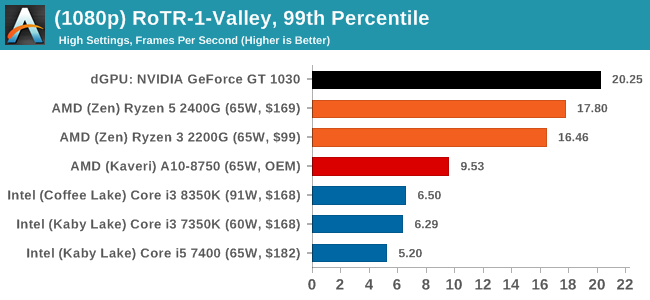
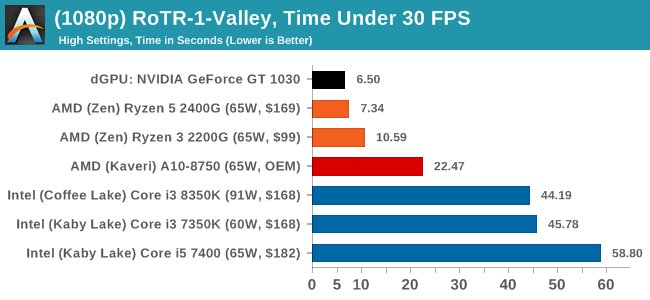
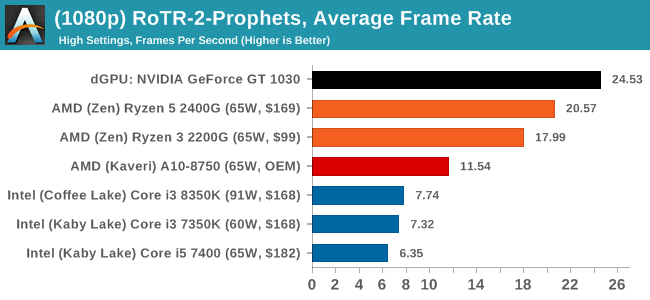
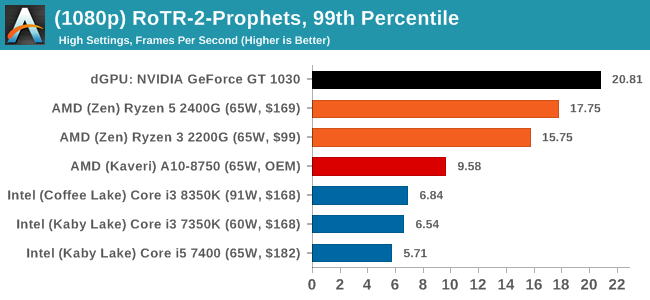
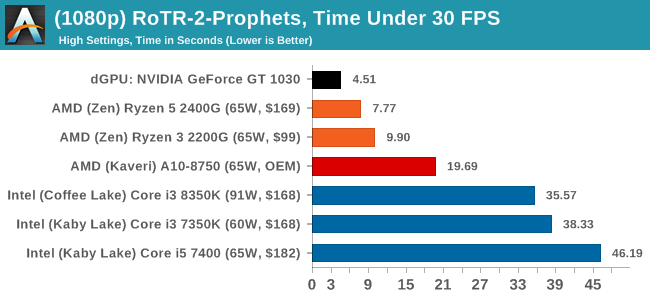

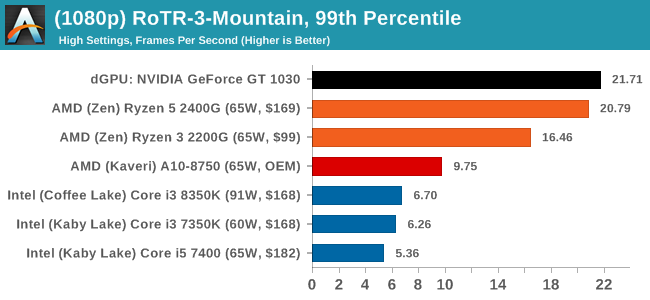
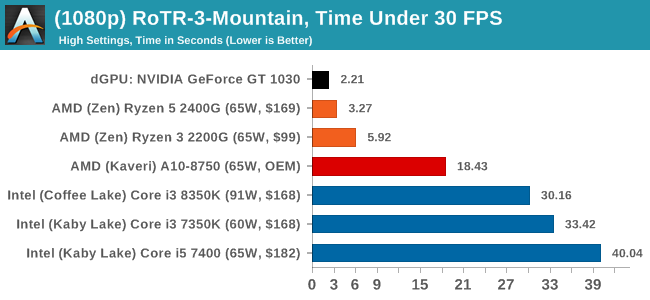
The GT 1030 sweeps the top spot against AMD here, though only by small margins most of the time. The AMD APUs still offer a commanding 2-3x performance jump over Intel's product line, and even more when price is factored into the equation.
Rocket League
Hilariously simple and embodying the elements of pick-up-and-play, Rocket League allows users to jump into a game with other people (or bots) to play football with cars with zero rules. The title is built on Unreal Engine 3, which is somewhat old at this point, but it allows users to run the game on super-low-end systems while still taxing the big ones. Since the release in 2015, it has sold over 5 million copies and seems to be a fixture at LANs and game shows. Users who train get very serious, playing in teams and leagues with very few settings to configure, and everyone is on the same level. Rocket League is quickly becoming one of the favored titles for e-sports tournaments, especially when e-sports contests can be viewed directly from the game interface.
With Rocket League, there is no benchmark mode, so we have to perform a series of automated actions, similar to a racing game having a fixed number of laps. We take the following approach: Using Fraps to record the time taken to show each frame (and the overall frame rates), we use an automation tool to set up a consistent 4v4 bot match on easy, with the system applying a series of inputs throughout the run, such as switching camera angles and driving around.
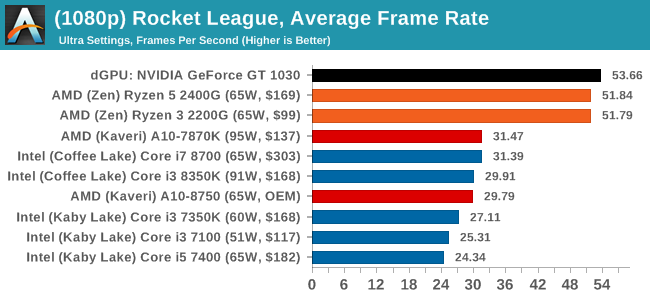
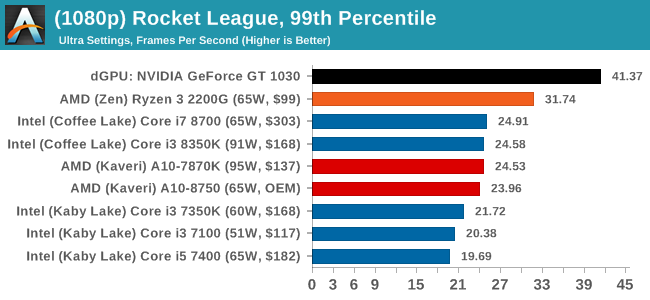

As the more eSports oriented title in our testing, Rocket League is less graphically intense than the others, and by being built on DX9, also tends to benefit from a good single thread performance. The GT 1030 wins again here, most noticably in the 99th percentile numbers, but the AMD chips are hitting 30 FPS in that percentile graph, whereas in the last generation they were getting 30 FPS average. That is a reasonable step up in performance, aided both to the graphics and the high-performance x86 cores. It will be interesting to see how the memory speed changes the results here.










177 Comments
View All Comments
speely - Monday, February 12, 2018 - link
"Where is the i5-8400 that has the same price as the 2400G?Oh, yeah, they totally left it out from the benchmarks since it would have proved an absolute supremacy of the Intel offering.
Ops."
In which benchmarks do you expect to see the i5-8400 prove its "absolute supremacy" where the i5-7400 didn't? Seriously, I'd like to know.
Because what I see is either the i5-7400 beating the 2400G or going punch to punch with it, or being thoroughly decimated by it.
If the i5-7400 beats or competes with the 2400G, the i5-8400 refresh chip will do the same. If the i5-7400 gets trounced by the 2400G, the i5-8400 refresh chip isn't suddenly and magically going to beat it.
I fail to see anything in the article to indicate a pro-AMD bias on AT's part, either intentional or unintentional.
What I do see is a fanboy who's upset to see his team losing some benchmarks.
Kamgusta - Monday, February 12, 2018 - link
Ehm sir, 7400 is 4 core and 8400 is 6 core.Other reviews shows a 30% performance dominance of i5-8400 over the 2400G.
speely - Monday, February 12, 2018 - link
Fair point, and my apologies. I keep forgetting that they upped the i5's to 6 cores after a decade of 4c4t i5's (including the 4690K I currently use).That being said, the i5-8400 itself is the same price as the 2400G, but getting the i5-8400 running is not the same price as getting the 2400G running. The 2400G was tested on an MSI B350I Pro AC (https://www.anandtech.com/show/12227/msi-releases-... which is new and doesn't yet have a publicly-known MSRP, but is built and featured like other $70-80 B350 motherboards. What motherboards are on the market today for $70-80 that support the i5-8400?
So we've taken into account the additional 2 cores and the subsequent boost to the CPU-focused benchmarks, which the 7400 sometimes lost and sometimes won against the 2400G, and put a couple small notches into the 8400's belt. For another 50 bucks or so on the motherboard just to use the 8400, that's not too bad I suppose. It's what I would expect pitting a 6c6t CPU against a 4c8t CPU in CPU benchmarks. It's certainly not "absolute supremacy" but it's something, right?
Were you expecting that "absolute supremacy" to show up in iGPU gaming? I'll just laugh about that and move on.
Sure, the 8400 could probably step past the 2400G in gaming and graphics if you paired it with a $120-or-so graphics card (assuming you can find one at $120 or so), but then you're comparing a dGPU to an iGPU and you're still only barely stepping past.
So the only real way to make the 8400 show "absolute supremacy" over the 2400G is to cherry-pick just the benchmarks you like, and bolster the 8400 with another $200 of additional hardware.
"Absolute supremacy".
Manch - Monday, February 12, 2018 - link
No it's not.In regards to vs the 8400, its a mixed bag. For programs that favor Intel CPU's there is a clear advantage. For programs that favor AMD the advantage swings the other way. For everything else that's generally proc agnostic they tie, pull ahead slightly or gets beat relatively evenly in regards to CPU performance.Now GPU wise, it gets crushed. That's obvious that is gonna happen.
If you plan on getting a DGPU with some beef, either is good, If you looking to game on the cheap, which is the target of the AMD proc in this review, its the hands down winner. Comparable perf, but with a beefier iGPU that can hang with a 1030. Also it gives you the option of adding a DGPU later when you need more grunt. It's clearly the better buy this go around. No other site that Ive seen has argued against this.
dromoxen - Tuesday, February 13, 2018 - link
Are these going to get a 12nm refresh , as all the other ryzen cpus? I am thinking of upgrade either i58400 or r5 1600/1700 or possibly 2400g.. decision decisions ...Manch - Wednesday, February 14, 2018 - link
Originally it was labeled as 12nm, now referred to 14nm+.Probably will be updated.cheshirster - Monday, February 12, 2018 - link
You need Z370 for the "supremacy" to work.Ops.
bug77 - Monday, February 12, 2018 - link
That will be fixed when lower tier 300-series chipsets launch. However, it's a significant problem for those wanting to build a cheap setup until then.Ian Cutress - Monday, February 12, 2018 - link
I used the chips I have on hand for the tests, forgot to add already tested chips - we haven't tested the i5-8400 IGP, but the CPU results are on hand in Bench. I can add those results to the graphs when I get a chance.Manch - Monday, February 12, 2018 - link
Ian, I dont know if fhis is just when browing from a phone but the bench when listing CPUs while alphabetic, bc of the chips names ~lake, etc. The listing jumps all over the place. 8 series before 4 seriez then 7 series. Can yall fix this? Thanks